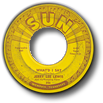
The Subtle Power of Illustrations:
An Examination of Race, Gender, and Diversity
As Expressed through Graphics and Photographs
In Elementary Reading Textbooks.
By Stephen R. Adamson
A Special
Report for Planet Gnosis
Wednesday, May 23, 2012
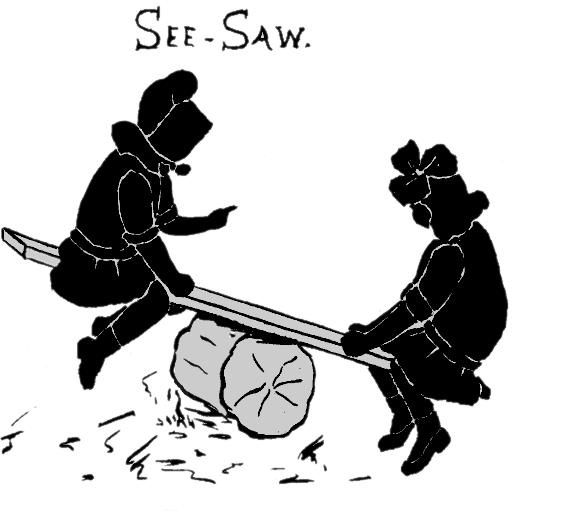
Illustration adapted from the Atlantic Educational Journal ~ Volume 10 June 1915 p383 ~ Digitized by Google
A B S T R A C T
Visual imagery is a powerful force in shaping the portrayal of race and gender in elementary reading textbooks. This research seeks to identify and analyze societal and cultural concepts tied to racial identity and gender role definitions through study of illustrations appearing in reading primers currently used in private and public schools in the United States. To the thoughtful educator, understanding of the power of graphics and photographs is essential to determining a textbook’s value for teaching literacy and promoting positive self-identity.
The study endeavors to answer four research questions related to the illustrations in elementary reading textbooks.
1. How many illustrations feature female main characters versus male main characters?
2. Is there a significant difference by publisher of the number of illustrations featuring female main characters versus male main characters?
3. How many illustrations feature minorities as compared to Caucasians?
4. Is there a significant difference by publisher of illustrations featuring minorities versus Caucasians?
A content analysis was conducted of the illustrations in the third grade reading textbooks of two publishers. One publisher was sampled from a public school curriculum while the other textbooks were sampled from a private Christian school curriculum. A secular and Christian publisher was chosen to identify differences between the representation of gender and race by publishers used in both public and private schools throughout the United States.
Results indicate that there are significant differences in gender and race in the illustrations in elementary reading textbooks. Males and Caucasians continue to dominate the illustrations in textbooks published by one of the leading Christian textbook publishers.

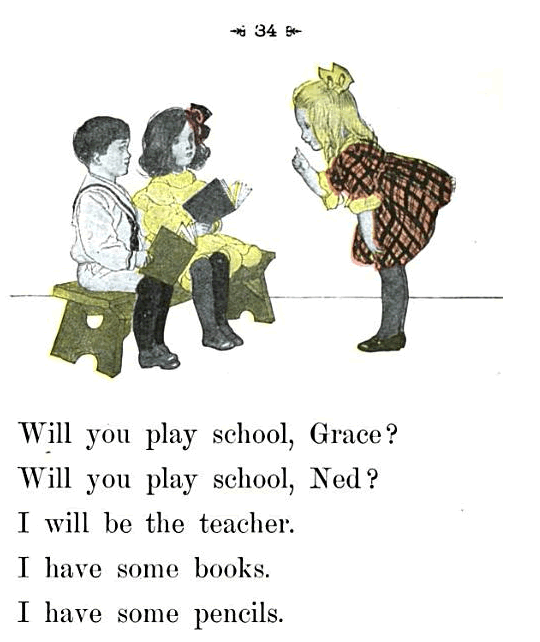
Illustration from The Wide Awake Primer by Ella Austin Blaisdell McDonald ~ Little, Brown, And Company 1908 p34 ~ Digitized by Google
I N T R O D U C T I O N
Popular textbook publishers, such as Macmillan, have noted that “children are not simply being taught mathematics and reading; they are also learning, sometimes subliminally, how society regards certain groups of people” (Evans & Davies, 2000). Other publishers have readily admitted that textbooks teach more than learning skills. Ginn and Company noted that through the use of textbooks, students are unconsciously taught either positive or negative attitudes concerning, among other things, race, gender and other ethnicities (2000). In this context of attitude and identity, have textbook companies equally represented all types of people regardless of race and gender in their pages?
According to statistics published by the United States Census (2005), many races make up the American nation. Caucasians represent almost 75 percent of the population. Minorities of various backgrounds, including African Americans, Native Americans, Asian Americans, and Hispanic Americans, represent the other 25 percent of the population. Population projections indicate that the Hispanic population will almost double by the year 2050, from 12.6 percent in 2000 to 24.4 percent in 2050, and will comprise the largest minority in the United States. With such diversity, the question is raised as to whether current textbooks used in the United States by students of all ethnic backgrounds are attuned to the world of the moment via the examples and illustrations they use.
Equally important is the issue of gender representation. In America today, males and females are roughly equal in number (2005). But for the many students who rely on elementary reading textbooks for their source of learning the question arises: Is gender accurately portrayed in text and illustrations?
Diversity in gender and ethnicity was rarely found in elementary reading textbooks published prior to 1970 (Britton & Lumpkin, 1976). The inclusion of various ethnicities and females into elementary reading textbooks began after events leading to changes in attitudes in the United States, such as the passing of the Civil Rights Act of 1964 (Marshall, 2002). The Civil Rights Act prompted publishers to include representations of minorities and females in textbooks. However, textbook publishers continued presenting minorities and females in secondary roles rather than as main characters (Butterfield, Demos, Grant, Moy and Perez, 1979).
In an effort to better understand the portrayals of race and gender being transmitted both consciously and subtly from textbook publishers, this research examines elementary reading textbooks currently used in private and public schools by American students.
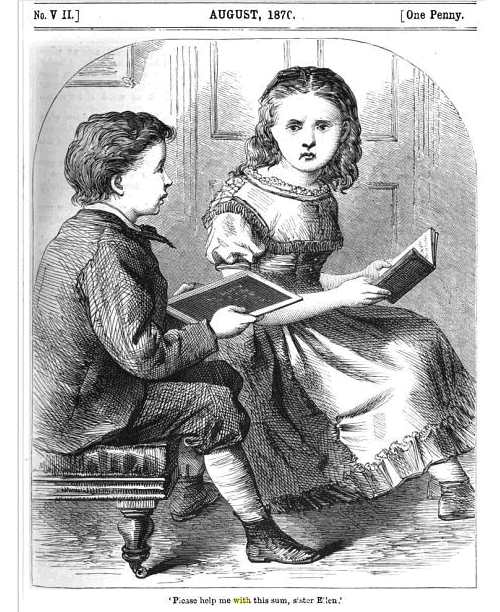
'Please help me with this sum, sister Ellen'
From The Children's Prize ~ No. VIII of August 1870 (selling at 'One Penny') ~ Digitized by Google
R E V I E W O F L I T E R A T U R E
A 1979 study by Butterfield, Demos, Grant, Moy, and Perez focused on the representation by race in popular elementary reading textbooks of the mid to late 1970s. The study found that many forms of racial bias were eliminated during the 1970s, through a comparison of earlier studies, even noting that well-known publisher Houghton Mifflin had issued guidelines to its authors concerning minority and female representation in textbooks. The guidelines suggested that textbooks were to include at least a twenty percent representation of minorities and a fifty percent representation of females.
The study analyzed the reading selections in five reading textbooks published by Houghton Mifflin in 1976, ranging from first through third grade. Each story was analyzed using three perspectives. Stories were categorized as “all” if it contained only one racial group and “multicultural” if it contained more than one ethnicity. For multicultural stories, characters were coded for the ethnicity of the principal character.
Results of the study indicated that Caucasians continued to dominate the stories in the fifty-two selections analyzed. Twenty-four (46 percent) of the stories included all white characters, while only seven stories (14 percent) included all black characters. For the 21 stories (40 percent) with both ethnicities represented, there were twelve white characters and nine minority, or non-white, characters considered principle characters in those selections.
A study of Native American representation in elementary reading textbooks was conducted by Reyhner (1986). First, third, and fifth grade readers of eight reading series published since 1978 and used in states with at least five million residents were analyzed for the representation of Native Americans. A stratified random sample included 25 percent of the stories in the textbooks for analysis. The results of the study found that of 203 stories analyzed, only 16 (7.9 percent) had representations of Native Americans. Of all the stories sampled and analyzed, white characters were seven times more likely to be portrayed than characters of other ethnicities.
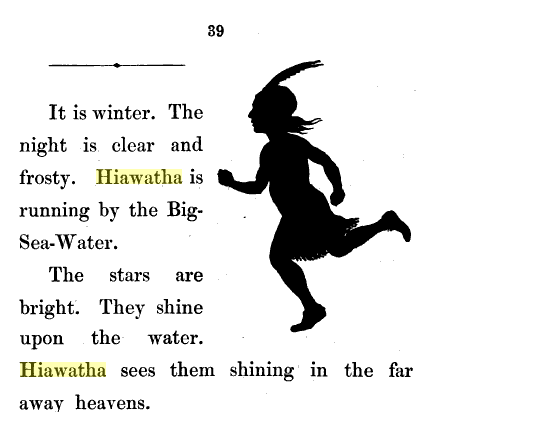
From The Hiawatha Primer by Florence Holbrook, Principal of Forestville School, Chicago 1898 ~ Digitized by Google
Dr. Ellen Lewis (1986), as part of her dissertation, focused on the representation of Hispanics in reading textbooks used in California. Dr. Lewis conducted a content analysis of first through third grade reading textbooks, coding characters as main or secondary and human or animal. Each character was also coded as Hispanic, Anglo, other, or unknown. Her research found that only eight percent of the characters in the fifty-two book sample were of Hispanic origin, indicating that Hispanics were not well represented in elementary reading textbooks. And at that time the population of California was 17 percent Hispanic.
Representation of another minority group, African Americans, was the focus of a study in 2005 by Brown-Levingston. The study focused on the portrayal and representation of African Americans in reading textbooks used at the first, third, and fifth grade levels. The selections and pictures were analyzed for African American representation. In addition to the characters in the textbooks, the researcher also examined the race and gender of authors for each selection in the readers.
There were several major findings from this research. Out of a total of 629 African American characters found in the textbooks, 82 (13 percent) were main characters. The vast majority, 510 (81.1 percent), were filler characters with little importance. The remaining 37 (5.9 percent) characters were categorized as secondary characters.
Gender is the focus of several studies of elementary reading textbooks. One such study was conducted by Kathryn Scott (1981) to analyze the representation of gender in elementary reading textbooks. Three hundred eighty-five stories in reading textbooks for grades one through six were randomly chosen. The content analysis examined, among other things, the sex of the main character. Each main character was coded and assigned
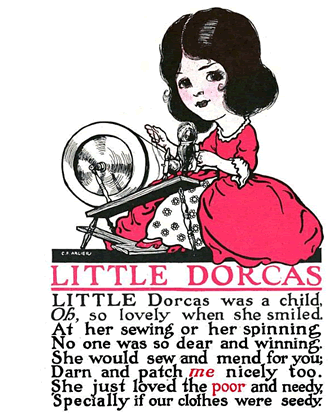 to one of four categories. The categories corresponded to the gender of the main character, or characters if more than one main character existed in a selection. The categories included female main character, male main character, female and male main characters, and neutral for stories without main characters.
to one of four categories. The categories corresponded to the gender of the main character, or characters if more than one main character existed in a selection. The categories included female main character, male main character, female and male main characters, and neutral for stories without main characters.
'Little Dorcas' represents a role model
much favored for young girls
in the early decades of the 20th Century.
She appeared in the 1917 edition
of John Martin's Annual:
A Jolly Big Book for Little Folks.
Scott's analysis indicates that 38 percent of main characters were male as compared to 31 percent for females. The other 31 percent were balanced with males and females or neutral for main character. She includes a comparison of reading textbooks published between 1974 and 1976. The dominance of male characters between these two studies was down from 61 percent in the earlier readers to 37.6 percent in the 1978 study.
On a slightly different track, a 1996 study by Witt focused on gender role orientation to identify traits attributed to males and females. A content analysis was conducted on 16 third grade reading textbooks published since 1993 using the Bem Sex Role Inventory in an effort to categorize each textbook as androgynous or traditional in the portrayal of gender. The characters were coded in four distinct categories. Male-male was assigned to male characters with stereotypical masculine traits: independent, assertive, forceful. Male-female was assigned to male characters exhibiting traits traditionally considered feminine: shy, gullible, gentle. Females were coded as female-female if the traits of the characters were typically feminine, and female-male if the traits were traditionally male.
The Witt study coded 3,933 traits. For male characters there was a total of 2351 traits examined. Of that total, 1,609 traits (68.4 percent) were coded as male-male, while 742 traits (31.6 percent) were coded as male-female. There were 1582 traits coded for female characters. Results indicated that female characters were slightly more balanced with 886 (56 percent) traits coded as female-male and 696 (44 percent) traits coded as female-female.
Hanna Nowakowska (1997) conducted a study of second grade readers used in three California school districts in an effort to determine the gender images represented. The content of all stories in three randomly chosen reading series were examined with the main unit of analysis being the individual story. Only fiction, biographies, auto-biographies, and dramas were analyzed. Each character was coded for, among other things, occupation. Results indicate that both male and female characters were presented stereotypically, such as female characters working in the home or as teachers, and male characters in the military or business setting. Although both genders received equal representation as followers, females were not well represented in leadership roles.
Other studies focusing on gender included a study by Evans and Davies (2000) of masculine portrayals in elementary reading textbooks. As in the Witt study, the Bem Sex Role Inventory was used. Thirteen elementary reading textbooks from two publishers were analyzed from the first, third, and fifth grade levels. First grade was analyzed for being the beginning of the educational sequence in learning to read. Third and fifth grade textbooks were analyzed because it was during those grades that national standardized testing takes place. The textbooks for the analysis were chosen based on the two series being used in the community where the researchers lived. They were interested in what children in their community were reading. Only fiction stories were analyzed for masculine portrayals, with a concentration on the main characters in each story. No photos or pictures were analyzed. The unit of analysis was the main character. Only selections containing the words “he” or “she” were included in the analysis.
The results of the study indicate that of 241 traits analyzed for male characters, 156 (64.7 percent) were traditional masculine traits while 85 (35.3 percent) were traditional feminine traits. There were 199 traits coded for female characters. Of those traits, 118 (59.3 percent) were considered traditional feminine traits and 81 (40.7 percent) were considered traditional masculine traits. Surprisingly, the third grade readers included more stereotypical portrayals of males and females than did the first and fifth grade readers.
While conducting research in preparation for this study, it was noted that no studies of gender and race in elementary reading textbooks focused on textbooks used in many Christian private schools or differences between publishers. The elementary reading textbooks often used in these schools are published through Christian educational publishers, allowing Christian schools the advantage of more textbook options than public schools. This study allows an opportunity to examine Christian-based textbooks in comparison with public school textbooks as a way of gauging what Christian school students are learning from their textbooks.
In an effort to better understand the issues of race and gender in elementary reading textbooks currently used by many private Christian schools, as well as those used by public schools, the following research questions will be addressed:
- Is there a difference in illustrations of males versus females?
- Is there a significant difference by publisher in illustrations representing females versus males?
- How many illustrations represent minorities versus Caucasians?
- Is there a significant difference by publisher in illustrations featuring minorities versus Caucasians?
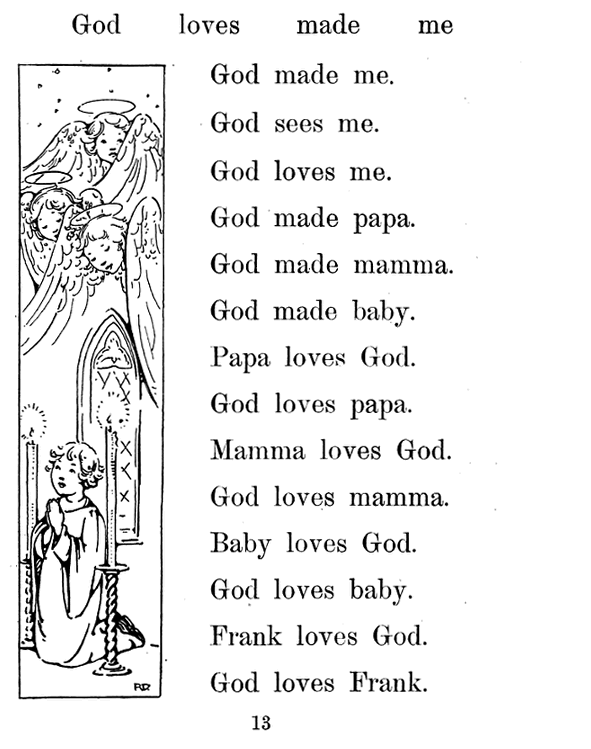
From The Ideal Catholic Readers Primer by Sister Mary Domitilla ~ The MacMillan Company New York 1915 p13 ~ Digitized by Google
M E T H O D
To answer the research questions, a content analysis of the illustrations of two elementary reading series was examined. The third grade reading textbooks from each series were content analyzed. Third grade was chosen because it is a year when students at that level take national standardized tests.
The two textbook series sampled include the current reading series by Houghton Mifflin used in public schools, as well as the A Beka Book Reading series used in many private Christian schools throughout the United States. These two series were chosen as a convenience sample. These two series were the only two readily available at the time of this study. The Houghton Mifflin third grade reading program consists of two reading textbooks. The A Beka Book series consists of five reading textbooks and two novels. Only the reading textbooks were examined. The accompanying novels were not examined because they were considered optional material. Using a series from both a secular publisher and a Christian based publisher provide more insight into the portrayals of race and gender being learned by all students, not just students attending public schools. A complete list of the textbooks sampled for this study is included in the appendix.
Before examination began, a coding sheet was created to analyze the illustrations in the textbook. A table format was created to allow for easier coding and tabulation. A copy of the coding sheet is located in the appendix. The coding sheet allowed each illustration to be coded for a variety of variables. The variables included page number, type of illustration, location of the illustration, and the size of the illustration. Although this information was not included in the research questions, coding for this allowed a more detailed and accurate description of the illustrations in the textbooks sampled.
Other categories in the coding sheet include a description of the illustration as black and white or color. The total number of characters in each illustration was noted, as well as the gender of all of the characters in the illustration. Separate categories were included to code for the gender of the main character and the ethnicities depicted in each illustration. A copy of the coding sheet and coding key are included in the appendix.
Operational definitions were also created to ensure that each category was mutually exclusive and mutually exhaustive. An illustration was described as any pictorial representation whether it was a photo or drawing. A reading selection was described as a fiction or non-fiction article not used in an explanation of a reading skill. Selections targeting specific skills and whose main purpose is to explain reading skills were referred to as a skill page.
For the categories of gender, there were several options. Male referred to one male character. Female referred to one female character. Multi all male indicates that there was more than one character included in the illustration but that all of the
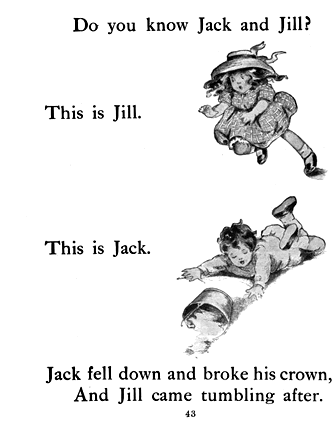 characters were male. Multi all female indicates that there was more than one character included in the illustration but that all of the characters were female. Illustrations with multiple characters of both genders were coded as multi-mixed.
characters were male. Multi all female indicates that there was more than one character included in the illustration but that all of the characters were female. Illustrations with multiple characters of both genders were coded as multi-mixed.
Gender neutral?
Jack and Jill are both tumbling
down the hill, but who is in the lead?
Illustration from The Child World Primer
by Bentley and Johnston ~ A. S. Barnes & Co. Publishers New York 1908
The category of race was divided into several options. The categories included Caucasian, African/African-American/Black, Asian/Asian American, Native American, and Hispanic. Indeterminate was used to refer to a character in an illustration whose ethnicity could not be determined. Mixed was used if a single character was of a mixed ethnic background.
When more than one race was represented, the illustration was labeled as mixed Black/Caucasian, Mixed Asian/Caucasian, Mixed Native American/Caucasian, or Mixed Hispanic/Caucasian. These illustrations included at least one Caucasian character in combination with a minority character. Should an all minority combination occur, it was noted.
Some operational definitions were borrowed and expanded from earlier studies of gender and race representation in textbooks. Hispanic refers to more than one culture. It refers to those characters whose origins and ancestors are of a Spanish speaking country (Butterfield, Demos, Grant, Moy & Perez, 1979). Main character refers to the character who is the primary focus of the illustration (Brown-Levingston, 2005). Minority refers to Black Americans, Spanish Americans, Asian Americans, and Native Americans (Kyle, 1978). This definition has been expanded to include any ethnicity other than Caucasian.
The main unit of analysis in each illustration was the characters, specifically the main character. Only illustrations containing human characters were coded. Illustrations not containing at least one human character were not coded. Twenty-four percent of the total illustrations were not coded because of the lack of human characters.
During coding, secondary characters were noted in the total number of characters and the gender of all the characters in the illustration. However, only the main character was coded in a separate category to indicate the gender of the main character. For this reason, the numbers indicating the gender of all characters may not always coincide with the gender of the main character.
A pilot study was conducted of several illustrations to ensure that the coding sheet was valid. Revisions were made to the coding sheet after the initial pilot study. A second pilot study was conducted using the revised coding sheet. This ensured that each category was mutually exclusive and mutually exhaustive.
Research questions 1 and 2 focus on gender representation. An examination of the illustration allowed the gender of the main characters to be calculated. Chi square tests were conducted to determine if there was a significant difference in the number of illustrations depicting females versus males. The chi square test was also applied in measuring significant differences in gender representation by publisher.
Research questions 3 and 4 shift the focus to the representation of minorities, or races other than Caucasians. A chi square analysis was conducted to measure differences in the representation of minorities compared to Caucasians. The analysis will also be applied in measuring significant differences in minority representation by publisher.
The major assumption of this study is that third grade reading textbooks will be similar to those of other grade levels. It is assumed that many attributes found in lower level reading textbooks are similar to the same format of the third grade textbooks. Third grade textbooks are also assumed to have many of the attributes of higher elementary reading textbooks. It is also assumed that the representation of gender and race by a publisher at one grade level will be similar to the same representation at other grade levels.
A major limitation of the study is that only illustrations are being examined. This does not provide detailed information about all of the races and characters presented in the illustrations. Another limitation is that only third grade is being examined. Other levels of the reading series are not being examined, indicating that it may not be a true picture of the complete reading series sampled for this study. An additional limitation is that reading textbooks of other publishers are not being sampled, which may not allow for an accurate representation of all elementary reading textbooks.
For each research question, a chi square test was used with a probability level of less than .05. This level is required for significance.
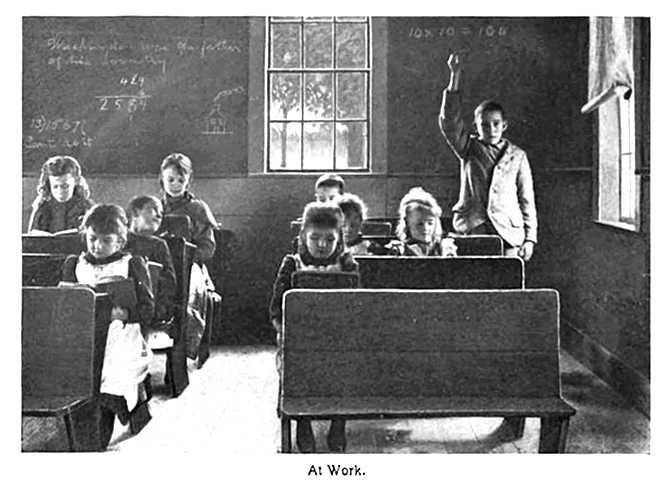
From Old-Time Schools and School-Books by Clifton Johnson ~ The MacMillan Company New York 1904 p132 ~ Digitized by Google
F I N D I N G S
A total of 822 illustrations were coded. 470 (57.2 percent) were from the Houghton Mifflin reading series. 352 (42.8 percent) of the illustrations were from A Beka Book. A total of 179 (21.8 percent) of the illustrations were photos. 643 (78.2 percent) illustrations were drawn illustrations. The majority of illustrations, 666 (81 percent) were found in reading selections, with an average of 1.9 illustrations per selection. Of the 666 illustrations coded in 350 different reading selections, there was an average of 1.9 illustrations per reading selections. Of the illustrations coded, 146 (17.8 percent) were full page illustrations. One hundred sixty three (19.8 percent) were between three-fourths and a full page. Illustrations between one-half and three-fourths of a page were found 116 (14.1 percent) times. There were 197 (24.0 percent) illustrations that were one-fourth to one-half of a page. The remaining illustrations, 200 (24.3 percent) were less than one fourth of a page.
Of the 822 illustrations coded, 411 (50 percent) contained male main characters. 289 (35.2 percent) illustrations contained female main characters, and balanced, equal representation of both male and female main characters was found in 106 (12.9 percent) of the illustrations. There were 16 (1.9 percent) illustrations where the gender of the main character was indeterminate (See table 1).
In examining race, the majority of characters, 497 (63.7 percent) were Caucasian and 81 (10.4 percent) illustrations contained African/African-American/Black characters. Asian/Asian-American characters were found in 74 (9.5 percent) illustrations. Native Americans were found in 29 (3.7 percent) of the illustrations, Hispanics in 59 (7.6 percent) illustrations and 8 (1.0 percent) characters were of Arabic descent.
Some of the illustrations represented more than one race. Mixed Black/Caucasian illustrations were found in 24 (3.1 percent) illustrations. One (.1 percent) illustration represented an Asian/Caucasian combination. A Hispanic/Caucasian mixture was found in 7 (.9 percent) illustrations. See table 4 in the appendix for totals by race and publisher.
Research question 1 asked if a majority of illustrations represented males versus females. Of the 822 illustrations, only 806 allowed for correct coding of the gender of the main character(s). Sixteen (1.9 percent) illustrations were coded as “indeterminate,” indicating that the gender of the main character could not be determined. 411 (50 percent) illustrations had male main characters, whereas 289 (35.2 percent) of the illustrations contained a female main character. 106 (12.9 percent) illustrations had more than one main character, with a balanced representation of both males and females. The results of the chi square analysis indicate that significantly more males are represented than females (411 to 289) as main characters (x2=21.2, df=1, p‹.05).
Research question 2 asked if there was a significant difference by publisher in illustrations representing females versus males. The Houghton Mifflin program contained 182 (39.4 percent) illustrations with male main characters. 193 (41.9 percent) of the illustrations were of female main characters. The A Beka Book program had 229 (70.5 percent) illustrations featuring male main characters. There were 96 (29.5 percent) illustrations featuring female main characters. The chi square analysis revealed that Houghton Mifflin features significantly more females than the A Beka Book program (x2=34.21, df=1, p‹.05). (See table 2.)
Research question 3 asked how many illustrations represent minorities versus Caucasians. 497 (63.7 percent) of the illustrations represented Caucasian characters. Minority characters were found in 283 (36.3 percent) illustrations. Based on statistical information it was expected that 75 percent of the illustrations would contain Caucasians while 25 percent of the illustrations would contain minorities. The results indicate that there are significantly more illustrations featuring Caucasians than minorities (497 to 283) (x2=52.9, df=1, p‹.05).
Research question 4 asked if there were significant differences in minority representation by publisher. The Houghton Mifflin program contained 232 (51.3 percent) illustrations featuring Caucasians. Minorities were found in 220 (48.7 percent) illustrations. The A Beka Book textbooks contained 265 (80.7 percent) illustrations with Caucasians. Minorities were found in only 63 (19.3 percent) illustrations. Results of the test indicate that Houghton Mifflin contains significantly more minority illustrations than A Beka Book (x2=71.36, df=1, p‹.05). A table of this information is included in the appendix.
Interestingly, during coding of the textbooks sampled, it was noted that the majority of illustrations were drawn illustrations instead of photos. Only 179 (21.8 percent) of illustrations were photos. The majority of illustrations were found in reading selections rather than in other sections of the textbook. This may be due to the fact that the Christian publisher, A Beka Book, contained no skill pages. Each of the A Beka Book textbooks contained only reading selections. Of those illustrations located within a reading selection for both publishers, 528 (64.2 percent) were found between the first and last pages of reading selections. Over one-half (51.2 percent) of the illustrations were single person illustrations.

From The Native American ~ Published by the Phoenix Indian School ~ Volume 17 of 1 July 1916 ~ Digitized by Google
C O N C L U S I O N
Elementary reading textbooks today seem more diverse than the elementary reading textbooks of the past. Earlier studies have indicated that there was not much diversity in elementary reading textbooks prior to the latter part of the twentieth century. A large number of students in both public and private schools use current elementary reading textbooks, allowing an advantage of a more representative curriculum than was available for students of the past.
Although textbooks are more diverse in representation, there are still discrepancies in the representation of gender and ethnicity. Caucasians and males continue to dominate the storylines and illustrations of elementary reading textbooks.
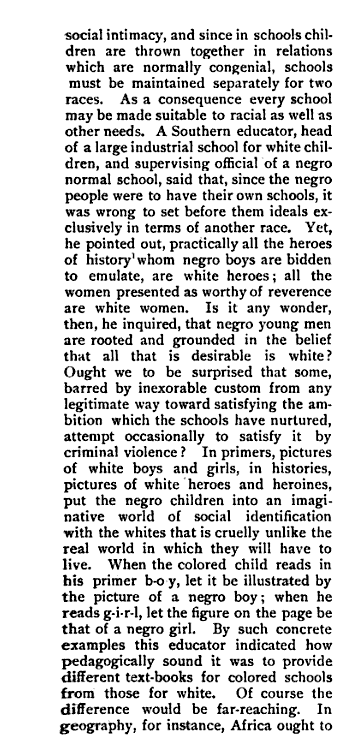 This is particularly evident in private Christian school textbooks. Based on the current study, these textbooks are not providing a true indication of the world for students who use these textbooks on a daily basis.
This is particularly evident in private Christian school textbooks. Based on the current study, these textbooks are not providing a true indication of the world for students who use these textbooks on a daily basis.
The text displayed to the right,
although rooted in the oppressive
and separatist Jim Crow attitudes
of the times, addresses
the issue of racial identification
in school textbooks.
It appeared in The Outlook,
Volume 77 of 1904, p743,
in an article by Ernest Hamlin Abbott,
"Education and Race Integrity."
The secular textbooks from publishers such as Houghton Mifflin seem more diverse and representative, but a closer examination still finds portrayals that may not truly reflect the lifestyle and cultures of particular ethnicities. Based on the present examination, there are instances where minorities continue to be depicted in past situations, leaving students with a depiction which misrepresents ethnic groups.
The current study finds that Houghton Mifflin, a publisher favored by many public schools, to be more balanced in the portrayal of race and gender. A Beka Book, a widely used Christian publisher, is not as diverse. Most of the illustrations from A Beka Book appear to be Caucasian males.
The number of females and males in the United States is roughly equal, but this is not reflected in the textbooks used in the current study. More males are represented in the textbooks than females. Representation of minorities in the textbooks sampled is more representative. Caucasians in the United States represent 75 percent of the population. In this study, Caucasians were in 63 percent of the illustrations. The other 36 percent of illustrations contained minority representations.
Although the current study gives an accurate representation of the publishers sampled, there are areas where the examination could be completed differently. With other elementary reading textbooks available, a more representative sample from both public and private school publishers would give a more accurate description of elementary reading textbooks. This includes sampling other grade levels. During coding of illustrations, each illustration could be coded for past or present setting to give an indication of how and when minorities and females are depicted.
While the current study focused solely on illustrations, future research could expand the examination to the actual reading selections. This would provide a more detailed explanation of diversity in elementary reading textbooks. An examination of the storylines would allow a more detailed explanation of the subject matter of each illustration. It may also be beneficial to examine the number of illustrations featuring children as compared with adults, including any professions that may be depicted in the illustrations and storylines. An examination of professions in addition to race and gender would give a more detailed description of how minorities and females are represented.
Future research could also be expanded to examine other grade levels. This would provide a more accurate depiction provided by publishers. This could also be expanded to examine reading textbooks of all publishers for both public and private schools. With a variety of options in curriculum, schools across the United States have the ability to choose from several publishers not only the publishers sampled for this study.
Studies of race and gender in textbooks would also benefit from analyzing textbooks at all grade levels. Students typically attend school for thirteen years. This allows a wide range of grade levels that could be analyzed for accurate representation of race and gender. It would also be beneficial to analyze textbooks from content areas such as science, history, and foreign languages. As students spend the majority of the day studying from different subjects, an examination of the ethnic and gender depiction from these content areas and textbooks is as equally important.
It is suggested that teachers choose textbooks for their students with great care and attention. As textbooks are examined for possible adoption by school districts, more factors than content and skill sets should be considered. Accurate gender and race representation should also be considered so that students using the textbooks will benefit from a more representative depiction of the world.
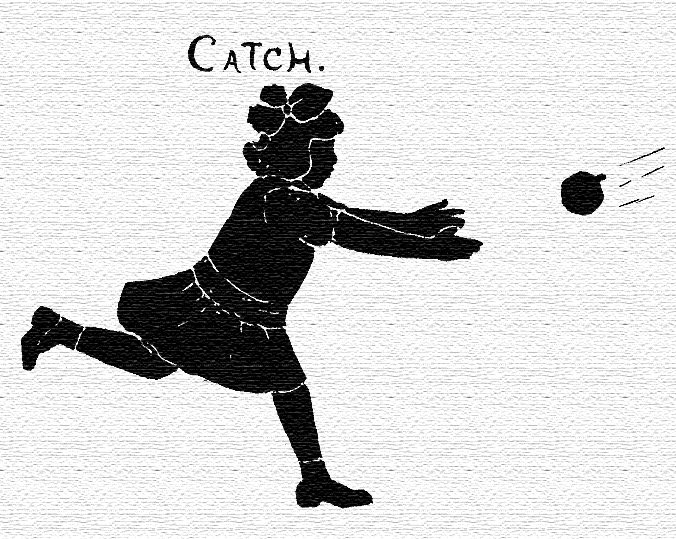
Illustration adapted from the Atlantic Educational Journal ~ Volume 10 June 1915 p382 ~ Digitized by Google

R E F E R E N C E S
![]() Britton, G.E, & Lumpkin, M.C. (1976). For sale: Subliminal bias in textbooks. ERIC ED140279.
Britton, G.E, & Lumpkin, M.C. (1976). For sale: Subliminal bias in textbooks. ERIC ED140279.
![]() Brown-Levingston, C.A. (2005). The portrayal of African Americans in the Texas state adopted reading textbooks: Grades one, three, and five (Doctoral Dissertation, Texas A & M University—Commerce, 2005). Dissertation Abstracts International, 66, 11.
Brown-Levingston, C.A. (2005). The portrayal of African Americans in the Texas state adopted reading textbooks: Grades one, three, and five (Doctoral Dissertation, Texas A & M University—Commerce, 2005). Dissertation Abstracts International, 66, 11.
![]() Butterfield, R.A., Demos, E.S., Grant, G.W., Moy, P.S., & Perez, A.L. (1979 Summer).
A multicultural analysis of a popular basal reading series in the international year of
the child. The Journal of Negro Education, 48(3), 382-389.
Butterfield, R.A., Demos, E.S., Grant, G.W., Moy, P.S., & Perez, A.L. (1979 Summer).
A multicultural analysis of a popular basal reading series in the international year of
the child. The Journal of Negro Education, 48(3), 382-389.
![]() Evans, L., & Davies, K. (2000). No sissy boys here: A content analysis of the
representation of masculinity in elementary school reading textbooks. Sex Roles,
42(3/4), 255-270.
Evans, L., & Davies, K. (2000). No sissy boys here: A content analysis of the
representation of masculinity in elementary school reading textbooks. Sex Roles,
42(3/4), 255-270.
![]() Kyle, D.W. (1978 May). Changes in basal reader content: Has anyone been listening?
The Elementary School Journal, 78(5).
Kyle, D.W. (1978 May). Changes in basal reader content: Has anyone been listening?
The Elementary School Journal, 78(5).
![]() Lewis, E.V. (1986). Representation of Hispanics in California state approved elementary
reading textbooks (Doctoral Dissertation, University of San Francisco, 1986).
Dissertation Abstracts International 47, 10.
Lewis, E.V. (1986). Representation of Hispanics in California state approved elementary
reading textbooks (Doctoral Dissertation, University of San Francisco, 1986).
Dissertation Abstracts International 47, 10.
![]() Marshall, C. (2002 Spring). Impediments to minority student learning. Inquiry,7(1).
Marshall, C. (2002 Spring). Impediments to minority student learning. Inquiry,7(1).
![]() Nowakowska, H.Z. (1997). The presentation of gender images in reading textbooks for
early elementary school children (Doctoral Dissertation, University of the Pacific,
1997). Dissertation Abstracts International, 58, 02.
Nowakowska, H.Z. (1997). The presentation of gender images in reading textbooks for
early elementary school children (Doctoral Dissertation, University of the Pacific,
1997). Dissertation Abstracts International, 58, 02.
![]() Reyhner, J. (1986 October). Native Americans in basal reading textbooks: Are there
enough? Journal of American Indian Education, 26(1).
Reyhner, J. (1986 October). Native Americans in basal reading textbooks: Are there
enough? Journal of American Indian Education, 26(1).
![]() Scott, K.P. (1981 April). Whatever happened to Jane and Dick? Sexism in texts
reexamined. Peabody Journal of Education, 58(3), 135-140.
Scott, K.P. (1981 April). Whatever happened to Jane and Dick? Sexism in texts
reexamined. Peabody Journal of Education, 58(3), 135-140.
![]() U.S. Census Bureau. (2005). American Fact Finder. Retrieved September 5, 2007,
from http://www.factfinder.census.gov
U.S. Census Bureau. (2005). American Fact Finder. Retrieved September 5, 2007,
from http://www.factfinder.census.gov
![]() Witt, S. (1996). Traditional or androgynous: An analysis to determine gender role
orientation of basal readers. Child Study Journal, 26(4), 303. Retrieved September 6,
2007, from Academic Search Complete database.
Witt, S. (1996). Traditional or androgynous: An analysis to determine gender role
orientation of basal readers. Child Study Journal, 26(4), 303. Retrieved September 6,
2007, from Academic Search Complete database.

A P P E N D I X
i. Coding Key: Textbook Illustrations
ii. Textbook Sample
iii. Table 1: Gender of Main Characters
iv. Table 2: Gender of Main Characters by Publisher
v. Table 3: Race
vi. Table 4: Race by Publisher
i. Coding Key: Textbook Illlustrations
Type of Illustration
1. Photo
2. Illustration
Location of Illustration
1. Cover
2. Title Page
3. Theme/Chapter Opener
4. Reading Selection
5. Skill Page
6. Background/Vocabulary
7. Theme Wrap-Up
If in actual article, WHERE?
1. first page of article
2. last page of article
3. only one page article/item
4. between first/last page
Location on Page
1. full page
2. top
3. middle
4. bottom
5. side
Size of Illustration
1. full page
2. ¾ to full
3. ½-3/4
4. ¼-1/2
5. ¼-0
Location in Illustration
1. foreground
2. background
Color/BW
1. color
2. black/white
Description of illustration:
1. single person
2. multi-person
3. multi all male
4. multi all female
7. multi-Indeterminate
Gender of all characters:
1. all male
2. all female
3. multi- all male
4. multi-all female
5. multi-mixed (male/female)
6. Other
7. Indeterminate
Gender of Main character
1. male
2. female
3. balanced (equal of both sexes)
7. Indeterminate
Race:
1. Caucasian
2. African/African American
3. Asian/Asian-American
4. Native American
5. Hispanic
6. Arabic
7. Indeterminate
8. Mixed
10. Mixed: Black/Caucasian
11. Mixed: Asian/Caucasian
12. Mixed: Native American/Caucasian
13. Mixed: Hispanic/Caucasian
ii. Textbook Sample
![]() Cooper, J.D. & Pikulski, J.J. (Eds.). (2005). Houghton Mifflin Reading: Horizons.
Boston, MA: Houghton Mifflin.
Cooper, J.D. & Pikulski, J.J. (Eds.). (2005). Houghton Mifflin Reading: Horizons.
Boston, MA: Houghton Mifflin.
![]() Cooper, J.D. & Pikulski, J.J. (Eds.). (2005). Houghton Mifflin Reading: Rewards.
Boston, MA: Houghton Mifflin.
Cooper, J.D. & Pikulski, J.J. (Eds.). (2005). Houghton Mifflin Reading: Rewards.
Boston, MA: Houghton Mifflin.
![]() Hicks, L. (Ed.). (1997). Better Bridges. Pensacola, FL: A Beka Book.
Hicks, L. (Ed.). (1997). Better Bridges. Pensacola, FL: A Beka Book.
![]() Hicks, L. (Ed.). (1986). Crossroads. Pensacola, FL: A Beka Book.
Hicks, L. (Ed.). (1986). Crossroads. Pensacola, FL: A Beka Book.
![]() Hicks, L. & DeKonty, J. (Ed.). (1986). Pilgrim’s Progress. Pensacola, FL: A Beka Book.
Hicks, L. & DeKonty, J. (Ed.). (1986). Pilgrim’s Progress. Pensacola, FL: A Beka Book.
![]() Hicks, L., Hedquist, M., Conrad, S. & Beck, D. (Eds.). Paths to Adventure. Pensacola, FL: A Beka Book.
Hicks, L., Hedquist, M., Conrad, S. & Beck, D. (Eds.). Paths to Adventure. Pensacola, FL: A Beka Book.
![]() Hicks, L., Hedquist, M., Conrad, S., & Beck, D. (Eds.). Worlds of Wonder. Pensacola, FL: A Beka Book.
Hicks, L., Hedquist, M., Conrad, S., & Beck, D. (Eds.). Worlds of Wonder. Pensacola, FL: A Beka Book.
iii. Table 1: Gender of Main Characters
| Male | 411 (50%) |
| Female | 289 (35.2%) |
| Balanced | 106 (12.9%) |
| Indeterminate | 16 (1.9%) |
| Total | 822 (100%) |
N=822
iv. Table 2: Gender of Main Character by Publisher
| Houghton Mifflin | A Beka Book | Total | |
| Male | 182 (39.5%) | 229 (66.4%) | 411 |
| Female | 193 (41.9%) | 96 (27.8%) | 289 |
| Balanced | 86 (18.6%) | 20 (5.8%) | 106 |
| Total | 461 (100 %) | 345 (100%) | 806 (100%) |
N=806
*16 illustrations were coded as Indeterminate for gender and have not been reflected in this table.
v. Table 3: Race
| Race | Total Number and Percent |
| Caucasian | 497 (60.5%) |
| African/African-American/Black | 81 (9.9%) |
| Asian/Asian-American | 74 (9.0%) |
| Native American | 29 (3.5%) |
| Hispanic | 59 (7.2%) |
| Arabic | 8 (1.0%) |
| Mixed: Black/Caucasian | 24 (2.9%) |
| Mixed: Asian/Caucasian | 1 (.1%) |
| Mixed: Hispanic/Caucasian | 7 (.9%) |
| Indeterminate | 42 (5.1%) |
| Total | 822 (100%) |
N=822
vi. Table 4: Race by Publisher
| Houghton Mifflin | A Beka Book | |
| Caucasian | 232 (51.3%) | 265 (80.1%) |
| African / African-American / Black | 59 (13.1%) | 22 (6.7%) |
| Asian/Asian-American | 57 (12.6%) | 17 (5.2%) |
| Native American | 23 (5.1%) | 6 (1.8%) |
| Hispanic | 51 (11.3%) | 8 (2.4%) |
| Arabic | 3 (.7%) | 5 (1.5%) |
| Mixed: Black / Caucasian | 19 (4.2%) | 5 (1.5%) |
| Mixed: Asian/Caucasian | 1 (.2%) | 0 |
| Mixed: Hispanic/Caucasian | 7 (1.5%) | 0 |
| Total | 452 (100%) | 328 (100%) |
N=780
*42 illustrations were coded as Indeterminate for race and have not been reflected in
this table.

A POSTSCRIPT FROM THE AUTHOR
E D I T O R ' S N O T E :
Stephen R. 'Ricky' Adamson is a Ph.D. student in the Department of Curriculum and Instruction at the University of Arkansas. His passion for teaching began in his first grade classroom in Forrest City, Arkansas, and continues apace as he pursues his postgraduate studies. After graduating with a B.S.E. in French from Arkansas State University, Ricky taught French and drove a school bus in his hometown. He later taught for Houston Independent School District in Houston, Texas, and Rogers Public Schools in Rogers, Arkansas. His diverse teaching background has inspired him to teach an equally diverse student population, leading to his research interests in multicultural education and the necessity of embracing each child’s uniqueness. During his studies for a Master's degree in Mass Communications at Arkansas State University, Ricky began to analyze the influence and impact of textbooks on the ability of children to learn how to read.
Ricky writes:
“Mmmm,” said Millie as she licked the ice cream cone. Such was my introduction to the world of reading. To help learn the sounds and letters, the elementary reading program at my school connected actions with letters. The characters performing each action appeared in illustrations on wall cards as well as in our reading workbooks.
At the time, I didn’t think anything of Millie appearing to be a white, middle class child, or the fact that the other characters we encountered in our reading books were also white and middle class. I connected with my learning experiences because the characters were similar to me.
Throughout elementary school, not much changed. Rarely do I remember encountering images of others different from me. Even a change in the reading textbook series didn’t seem to change this phenomenon. Today, in retrospect, I wonder about some of my classmates who never saw characters like them. How did they connect to the world of reading? Did they connect at all?
And what about today's students? Do they see the illustrations in their textbooks as mirrors, or do they stand on the outside, looking through a window into another world?
As time passed and I eventually became a teacher, I noticed that some students easily connected to the material being taught, while others considered it something foreign to them. It began to dawn on me that if students could not connect to the material or see themselves doing the same things that were illustrated in the textbooks, then perhaps the subject matter was irrelevant.
Everyone needs to feel valued and accepted, but do the textbooks that continue to permeate and influence American classrooms provide a “snapshot” that allows all students to feel connected, accepted, and valued?
Elementary school is said to be the time that “makes or breaks” a student. Without a strong foundation in the early years, students often fall further and further behind. The textbooks we use to help lay that foundation should provide a realistic portrait of the world in which we live. In this light, I decided to examine how contemporary textbooks at the third grade level portray our world. More specifically, I sought answers to a fundamental question: Do the basal reading textbooks popular today allow ALL students to feel understood and valued?
My research into elementary reading textbooks — for both public and private school students — provides a "picture" of how of race, gender, and diversity are represented in third grade textbooks in public and private sectors of education.
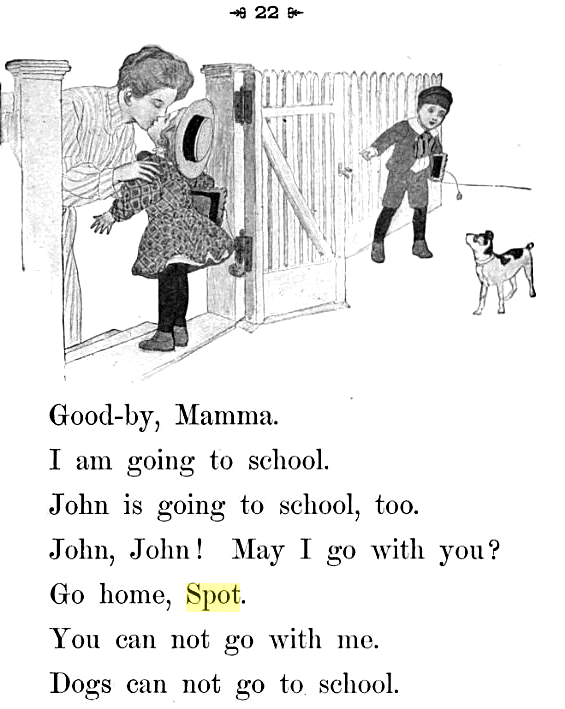
Illustration from The Wide Awake Primer by Ella Austin Blaisdell McDonald ~ Little, Brown, And Company 1908 p22 ~ Digitized by Google














